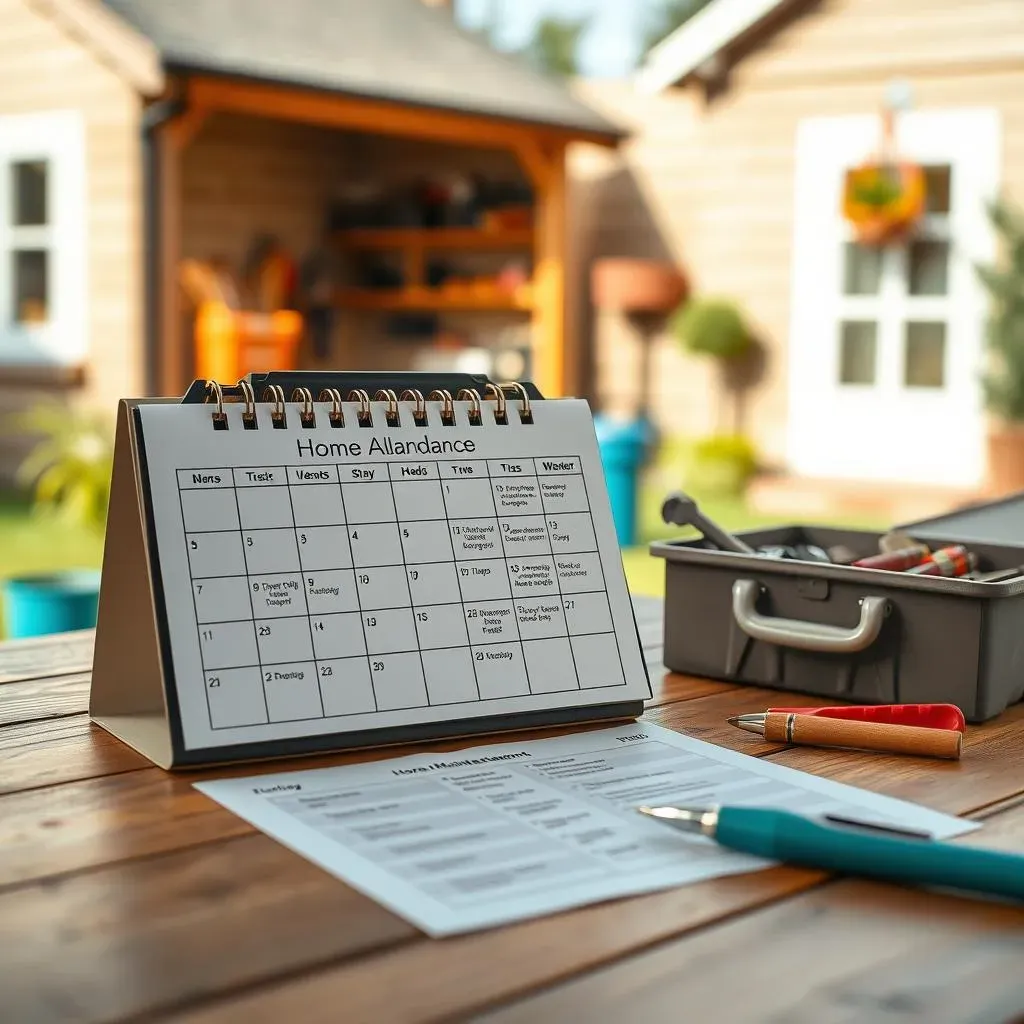Table of Contents
Ever feel like your house is a mystery machine, full of quirks and hidden needs? You're not alone. Many homeowners, especially first-timers, find themselves bewildered by the sheer amount of upkeep a home requires. That's where a good home maintenance manual comes in handy. Think of it as your home's instruction book, the one they forgot to hand you at closing. This isn't about becoming a master plumber or electrician overnight, but about understanding the basic care your home needs to stay happy and healthy. We'll explore why every homeowner should have a maintenance manual, the essential tasks it should cover, and how to choose one that's right for you. Get ready to ditch the guesswork and become a more confident, proactive homeowner. We'll tackle the essential tasks that keep your home in tip-top shape, from checking your roof to cleaning your gutters. And we'll help you figure out which manual is your perfect match, so you can keep your house humming along without any drama.
Why Every Homeowner Needs a Home Maintenance Manual
Why Every Homeowner Needs a Home Maintenance Manual
The Cost of Neglect
Let's be real, ignoring your home's needs is like ignoring a leaky faucet – it's not going to fix itself. Small issues, like that tiny roof leak or a clogged drain, can quickly snowball into major, expensive problems. A home maintenance manual is your early warning system. It helps you catch these potential disasters before they turn into a full-blown crisis. Think about it: a few minutes of preventative maintenance can save you thousands of dollars (and a whole lot of stress) down the road. It's like having a cheat sheet for keeping your biggest investment in good shape. Ignoring maintenance is basically throwing money down the drain, and nobody wants that.
Plus, it’s not just about the money. A well-maintained home is a safer home. Regular checks can prevent things like electrical fires or carbon monoxide leaks, keeping your family safe and sound. It might seem like a chore now, but it’s a small price to pay for peace of mind. Trust me, a little proactive care goes a long way and prevents future headaches. So, that home maintenance manual is not just a book, it's a peace of mind tool.
Long-Term Value and Peace of Mind
Beyond saving money and preventing emergencies, a home maintenance manual is your secret weapon for preserving your home's value. A well-cared-for home is more appealing to potential buyers. When you decide to sell, you'll be able to command a higher price and sell it faster because everything is in good working order. It shows that you’ve been a responsible homeowner. It's like the difference between a car that's been meticulously maintained and one that's been driven hard and put away wet. Which one do you think is worth more? It's the same with houses.
Having a manual is also about taking control. It’s about knowing what to do and when to do it. It eliminates the feeling of being overwhelmed by your home. It's about understanding your home and taking care of it. It's about building confidence in your ability to handle things. No more calling a handyman for every little issue, you'll be able to tackle a lot of the small tasks yourself. And that feeling of competence? That's priceless.
Benefit | Description |
|---|---|
Cost Savings | Prevents small issues from becoming expensive problems. |
Safety | Helps identify potential hazards like electrical issues or leaks. |
Increased Home Value | Maintains your home's condition, increasing its resale value. |
Peace of Mind | Provides control and reduces stress related to homeownership. |
Essential Home Maintenance Tasks: A Practical Guide
Essential Home Maintenance Tasks: A Practical Guide
Seasonal Checks: Keeping Up with the Calendar
Okay, so you've got your home maintenance manual, now what? It’s time to get hands-on. Think of your home's maintenance like a seasonal wardrobe change. Just as you swap out your shorts for sweaters, your home needs some seasonal TLC too. Spring is a great time to check for any winter damage, like cracks in the foundation or roof issues. Summer is perfect for cleaning out gutters and making sure your AC is running smoothly. Fall is all about preparing for the cold, like sealing windows and doors. And winter? That's when you'll want to keep an eye on your heating system and check for ice dams.
Don't just wait for something to break. Proactive seasonal checks can help you catch problems early, before they become major headaches. A good maintenance manual will outline these tasks based on the time of year. It's like having a checklist for your house, so you don't forget anything important. It’s not about spending your whole weekend doing chores, but about setting aside a little time each season to make sure everything is shipshape. Think of it as a check-up for your home, keeping it healthy and happy.
Regularly Scheduled Tasks: The Daily and Monthly Must-Dos
Beyond the big seasonal checks, there are also some regular tasks you should be doing to keep your home running smoothly. These are the small, consistent things that make a huge difference over time. We're talking about things like changing your air filters every month to keep your air clean and your HVAC system efficient. Or checking your smoke detectors and carbon monoxide detectors to make sure they're working properly. These tasks might seem minor, but they're crucial for your home's health and your family's safety.
Also, don't forget about the simple, everyday stuff. Like cleaning your garbage disposal regularly to prevent clogs and bad smells. Or checking your faucets and toilets for any leaks. These small leaks can waste a lot of water and increase your water bill. A home maintenance manual will provide a schedule for these tasks, so you can stay on track. It’s all about creating good habits and making home maintenance a part of your routine. It's not about making your house spotless all the time, it's about making sure it's functioning well and safely.
Task Type | Frequency | Examples |
|---|---|---|
Seasonal | Every Season | Checking roof, gutters, sealing windows |
Monthly | Every Month | Changing air filters, testing detectors |
Regular | Weekly/Daily | Cleaning disposal, checking for leaks |
Choosing the Right Home Maintenance Manual for You
Choosing the Right Home Maintenance Manual for You
Finding Your Perfect Match
Okay, so not all home maintenance manuals are created equal. It’s like finding the right pair of shoes; what works for one person might not work for another. Some manuals are super detailed, with lots of technical jargon, while others are more basic and easy to understand. Think about your own comfort level. If you're a DIY newbie, you'll probably want a manual that uses simple language and lots of pictures. If you're more experienced, you might prefer a more comprehensive manual that covers all the nitty-gritty details. It's not about the fanciest manual, it's about the one that you'll actually use. So, before you buy, check out the table of contents and see if it covers the things you need to know.
Also, consider the age and type of your home. A manual for a brand-new house might not be as helpful for an older home with different systems. Some manuals are specific to certain types of homes, like condos or historic properties. And if you live in a region with specific climate challenges, like extreme heat or cold, you'll want a manual that addresses those issues. It's about finding a manual that matches your unique needs and situation. Don't just grab the first one you see. Do a little research and find the one that’s the best fit for your home.
Key Features to Look For
When you’re browsing for a home maintenance manual, there are a few key features you should keep an eye out for. First, check if it has a good index and a table of contents. You want to be able to find the information you need quickly and easily. Nobody wants to spend 20 minutes flipping through pages to find out how to fix a leaky faucet. Second, look for clear, easy-to-understand language. Avoid manuals that use complicated technical terms that sound like they are speaking a different language. The best manuals use simple language that everyone can understand. Look for lots of diagrams, pictures, and illustrations. A picture is worth a thousand words and can make complex tasks much easier to understand.
Finally, see if it includes a maintenance schedule. A good manual should help you stay organized by providing a list of tasks to do each season. A checklist can be a lifesaver when it comes to home maintenance. It keeps you from forgetting things and helps you stay on track. Also, look for resources and a glossary of terms. This will help you understand unfamiliar terms and give you a place to go for more information. It’s all about finding a manual that’s not just informative, but also practical and easy to use. The goal is to make home maintenance less of a chore and more of a manageable part of your life.
Feature | Description |
|---|---|
Clear Language | Avoids technical jargon, easy to understand. |
Visual Aids | Includes diagrams, pictures, and illustrations. |
Maintenance Schedule | Provides a checklist for seasonal and regular tasks. |
Index and Table of Contents | Easy to find information quickly. |
Glossary & Resources | Explains terms and offers additional help. |
